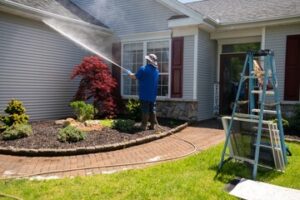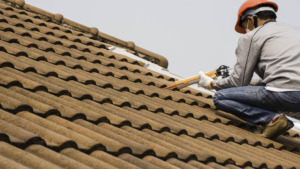Pressure Washing is an effective cleaning method for removing dirt, mold, mildew and debris from surfaces. It can also be used to clean vehicles, driveways and other outdoor areas.

It requires a knowledgeable operator to understand how the machine works and the correct pressure settings for different surfaces. Without this, damage may occur to the surface being cleaned. Visit Website to learn more.
Pressure washing uses high-powered water to remove dirt, grime, mildew, mold, and other debris from various surfaces around your home. Using the proper psi, rotation, nozzle, and cleaning products is essential to avoid damaging surfaces like siding, windows, doors, decks, driveways, outdoor furniture, and other equipment and structures. Professionals know how to adjust the pressure and nozzle for optimal results.
Using a specialized detergent or cleaning solution enhances the effectiveness of pressure washing for stubborn stains and contaminants. The force of the water combined with the chemical solution creates turbulence that helps break apart and disperse stubborn messes for easier removal. The hot water temperature of a pressure washer also increases the efficacy of detergents and helps detach oily and greasy substances for more effective cleaning.
Concrete surfaces such as sidewalks and driveways are typically easy to clean using a pressure washer, but it is important to use a low-pressure setting, a wide spray angle, and to stay away from cracks and expansion joints. It’s also a good idea to cover surrounding plants with tarps or move them temporarily during cleaning to protect them from the spray. Be sure to sweep away any loose dirt before applying a concrete-friendly detergent.
Dirty pressure-washing runoff contains oil, soap, chemicals, metals, and other pollutants that can harm wildlife and pollute waterways and groundwater. These substances are washed into storm drains, which eventually flow toward surface water and groundwater sources. When ingested by fish or other animals, they can cause illness or even death.
A pressure washer is an excellent tool for removing loose paint and rust from surfaces like fences, carports, and decks. But it’s important to be careful when attempting to do this on your own. Using the wrong nozzle or level of pressure could damage or chip the paint. Additionally, if the nozzle is too close to the surface, it could damage or etch the concrete or masonry. When attempting to paint or rust-remove, it’s best to hire a professional who can do an expert evaluation and use the correct nozzle and levels of pressure.
Prevents Mold and Mildew
Mold and mildew are a real issue for homes with vinyl siding. In addition to their unsightly appearance, they can also cause structural damage and create a health threat for family members with allergies or respiratory issues. In addition, the fungi can eat away at surfaces if left unchecked, leading to costly repairs in the future. Regularly cleaning outdoor surfaces using professional pressure washing prevents these blemishes from forming and keeps your home looking its best.
In addition to cleaning away existing spores, professional pressure washing removes the microscopic food sources that feed mold and mildew. These organic materials can be found in the form of leaves, grass cuttings, twigs and dirt that accumulate on hard outdoor surfaces over time. A thorough cleaning will eliminate these food sources and starve the fungi of their sustenance, significantly decreasing the chance of them returning.
Another way to reduce the likelihood of mold and mildew growth is to make sure that the area stays dry. This can be difficult in areas that experience frequent rainfall, but regularly clearing away standing water can help. In addition, ensuring that gutters are working properly and that there is adequate drainage around the property can also improve moisture conditions.
It is also important to note that mold and mildew thrive in damp environments. While they may disappear from outdoor surfaces after a thorough cleaning, they can return if the proper conditions are present. Mold spores are airborne and can spread to other parts of the house through open windows, so it is crucial to clean outdoor spaces often.
Regularly cleaning exterior surfaces like walkways and driveways with professional power washing helps to reduce the risk of fungus growth and improve the overall appearance of your property. Unlike other cleaning methods that can damage delicate materials, this type of cleansing is safe for most outdoor surface and won’t cause any harm to surrounding plants or structures. If you’re not sure how frequently you should be washing your outdoor spaces, contact a professional to discuss the recommended maintenance schedule for your property.
Prevents Damage
Pressure washing involves a high-powered water spray that can reach into crevices and cracks, eradicating spores like mold and mildew that may otherwise go unnoticed. This prevents them from growing and damaging the surface, and it also helps protect the structure of the building.
Regular pressure washing can help prevent a wide range of damages, including wood rot and concrete deterioration. It can also reduce the need for costly repairs and replacements. Pressure washing also enhances the appearance of your property, making it look newer and more appealing. This can improve your home’s curb appeal and increase its resale value when it comes time to sell.
Cleaning surfaces with a brush or hose is labor-intensive and time-consuming, while pressure washing is fast and effective. Professionals know how much pressure to use based on the material type and condition of each surface being cleaned. They can also adjust the temperature and choose the proper cleaning chemicals to avoid stripping or causing surface damage. They can even apply the washing solution at a safe distance from the surface to avoid staining.
Working with a power washer can be dangerous for those without the right training and experience. When not performed correctly, the strong jets of water can cause permanent damage to surfaces and structures. Professional cleaners use only industrial-grade equipment and know what kind of pressure to use for each surface. They also know how to handle and dispose of wastewater correctly, preventing environmental damage.
Many people try to perform pressure washing themselves, but this can lead to serious damage if not done properly. Inexperienced cleaners may use too much pressure or the wrong cleaning chemicals and can strip paint, splinter decks and break windows. When used incorrectly, pressure washing can even be dangerous to your health. By hiring a professional cleaner, you can be sure that your property is in good hands and that the cleaning process will be quick and efficient. They will also take care to protect plants, shrubs and other objects in the area from accidental damage. A reputable cleaner will carefully scan the area surrounding your house before starting, ensuring that there are no delicate areas that might be affected by the high-pressure water spray.
Restores the Appearance
Pressure washing is an effective way to remove unsightly marks, such as oil stains on driveways and mildew on sidings and walkways. It also sanitizes surfaces, killing off mold spores and bacteria to prevent their regrowth.
A professional cleaning with a high-powered washer can also prepare surfaces for a fresh coat of paint. It eliminates dirt, rust, and flaking paint to provide a smooth canvas for the new coat. Performing this step before painting or staining helps the surface last longer and look better, as well as protects against moisture damage and other issues down the line.
In urban areas, where building facades and sidewalks are often exposed to air pollution and pedestrian traffic, they can become dull and unattractive over time. Regular cleaning with a pressure washer, however, can help restore their original appearance and improve the overall visual appeal of a neighborhood.
Additionally, pressure washing is an effective tool for removing difficult-to-remove stains, such as graffiti and spray paint, from buildings. This can help deter future acts of vandalism and maintain a clean, safe environment for residents.
Pressure washing is a fast and efficient cleaning method that can be used to clean a variety of surfaces, from concrete and asphalt to brick, stucco, and wood. The heat generated by the powerful water stream makes it especially effective at breaking down tough substances like grease, oil, and industrial grime. Moreover, it can be used to quickly and effectively clean surfaces that are not easily accessible, such as tall buildings or rooftops. The wide range of available nozzles allows for customized applications, including dispersing the water flow and pressure to match specific cleaning needs. This versatility makes pressure washing a cost-effective and effective alternative to traditional cleaning methods. This is especially true for large commercial and residential properties where thorough cleaning is required on a frequent basis. In addition, it can be used to clean outdoor furniture and vehicles, which can be difficult to wash manually.

